A Study of the Elemental Profiles of Wines from the North-Eastern Coast of the Black Sea
Abstract
1. Introduction
2. Materials and Methods
2.1. Research Materials
2.2. Research Methods
2.2.1. Atomic Emission Analysis (ICP-AES)
2.2.2. Mass Spectral Analysis (ICP-MS)
2.2.3. Statistical Methods of Analysis
3. Results and Discussion
3.1. Comparative Study of Elemental Profile of Wine Samples from Crimea and Kuban
3.2. Comparative Study of Elemental Profile of Wine Samples from Different Soil and Climatic Zones of Crimea
3.3. Comparative Study of Elemental Profile of Wine Samples from Different Vintage Years
3.4. Analyzing the Elemental Profile of Wines Using Machine Learning Methods
- -
- Maximum depth of decision trees—2;
- -
- Maximum fraction of parameters used by each decision tree—0.2;
- -
- Maximum number of leaves—7;
- -
- Minimum number of samples in leaves—1;
- -
- Minimum number of samples in a node to perform split—5;
- -
- Number of trees in the ensemble—30.
- -
- Maximum depth of decision trees—4;
- -
- Maximum fraction of parameters used by each decision tree—0.2;
- -
- Maximum number of leaves—9;
- -
- Minimum number of samples in leaves—1;
- -
- Minimum number of samples in a node to perform split—6;
- -
- Number of trees in the ensemble—10.
- -
- All samples—0.96;
- -
- Sample for 2020—0.93;
- -
- Sample for 2021—0.93;
- -
- Sample for 2022—0.98;
- -
- Sample for 2023—1.
- Elements whose high and low concentrations unambiguously point to the origin of the sample. These elements provide the most explicit clue about the origin of the element. For instance, a high concentration of Ni is tipping the scales heavily towards Kuban, and obviously, a low concentration of Ni suggests a Crimean origin. Such elements include the following: high concentration for Kuban: Ni, Rb, Zn and Cd; and high concentration for Crimea: Re, U, Sb, Ti and Lu.
- Elements whose high or low concentrations point to the origin of the sample. Let us consider Ba: its high concentration unequivocally tells us that a sample has a Kuban origin. At the same time, a low concentration of Ba cannot be used alone to determine the origin, because both Kuban and Crimean samples can have a low Ba concentration. Elements from this group are the following: high concentration for Kuban: Ba, Na and Mo; low concentration for Kuban: Mg; high concentration for Crimea: Bi, Ag and Zr; and low concentration for Crimea: P.
- Mixed elements, the concentration of which alone cannot tell us with certainty the origin of the sample. For example, in the case of Si, most samples with a low Si concentration are located in Crimea, but nonetheless, a small number of samples with low Si were found in Kuban. Such elements include Si, Tl and Li. Therefore, a combination of elements from the first and second group can be used to determine whether the sample came from Kuban or from Crimea. A study of the elemental profile using machine learning is the most reliable method of classifying wines according to their place of origin. At the same time, an important stage is the annual monitoring of the elemental profile of wines in the studied regions and additional training of the model on new data.
4. Conclusions
Supplementary Materials
Author Contributions
Funding
Data Availability Statement
Conflicts of Interest
References
- Camin, F.; Dordevic, N.; Wehrens, R.; Neteler, M.; Delucchi, L.; Postma, G.; Buydens, L. Climatic and geographical dependence of the H, C and O stable isotope ratios of Italian wine. Anal. Chim. Acta 2015, 853, 384–390. [Google Scholar] [CrossRef] [PubMed]
- Dutra, S.V.; Adami, L.; Marcon, A.R.; Carnieli, G.J.; Roani, C.A.; Spinelli, F.R.; Leonardelli, S.; Vanderlinde, R. Characterization of wines according the geographical origin by analysis of isotopes and minerals and the influence of harvest on the isotope values. Food Chem. 2013, 141, 2148–2153. [Google Scholar] [CrossRef] [PubMed]
- Dordevic, N.; Wehrens, R.; Postma, G.J.; Buydens, L.M.C.; Camin, F. Statistical methods for improving verification of claims of origin for Italian wines based on stable isotope ratios. Anal. Chim. Acta 2012, 757, 19–25. [Google Scholar] [CrossRef] [PubMed]
- Camin, F.; Bontempo, L.; Perini, M.; Tonon, A.; Breas, O.; Guillou, C.; Moreno-Rojas, J.M.; Gagliano, G. Control of wine vinegar authenticity through δ18O analysis. Food Control 2013, 29, 107–111. [Google Scholar] [CrossRef]
- Scheidegger, Y.; Saurer, M.; Bahn, M.; Siegwolf, R. Linking stable oxygen and carbon isotopes with stomatal conductance and photosynthetic capacity: A conceptual model. Oecologia 2000, 125, 350–357. [Google Scholar] [CrossRef] [PubMed]
- Sviridov, D.A.; Ganin, M.Y.; Il’in, A.A.; Shmigelskaya, N.A. Study of the features of the elemental profile of wines of the Bakhchisarai region of the Republic of Crimea. Food Ind. 2023, 8, 71–77. [Google Scholar] [CrossRef]
- Oganesyants, L.A.; Panasyuk, A.L.; Kuzmina, E.I.; Sviridov, D.A.; Likhovskoy, V.V.; Zagoruiko, V.A.; Shmigelskaya, N.A. Isotopic characteristics of Crimean collection wines. Food Syst. 2023, 6, 431–436. [Google Scholar] [CrossRef]
- Pepi, S.; Vaccaro, C. Geochemical fingerprints of “Prosecco” wine based on major and trace elements. Environ. Geochem. Health 2018, 40, 833–847. [Google Scholar] [CrossRef] [PubMed]
- Fan, S.; Zhong, Q.; Gao, H.; Wang, D.; Li, G.; Huang, Z. Elemental profile and oxygen isotope ratio (δ18O) for verifying the geographical origin of Chinese wines. J. Food Drug Anal. 2018, 26, 1033–1044. [Google Scholar] [CrossRef]
- Azcarate, S.M.; Martinez, L.D.; Savio, M.; Camiña, J.M.; Gil, R.A. Classification of monovarietal Argentinean white wines by their elemental profile. Food Control 2015, 57, 268–274. [Google Scholar] [CrossRef]
- Coetzee, P.P.; Jaarsveld, F.P.; Vanhaecke, F. Intraregional classification of wine via ICP-MS elemental fingerprinting. Food Chem. 2014, 164, 485–492. [Google Scholar] [CrossRef] [PubMed]
- Geana, I.; Iordache, A.; Ionete, R.; Marinescu, A.; Ranca, A.; Culea, M. Geographical origin identification of Romanian wines by ICP-MS elemental analysis. Food Chem. 2013, 138, 1125–1134. [Google Scholar] [CrossRef] [PubMed]
- Wu, H.; Lin, G.; Tian, L.; Yan, Z.; Yi, B.; Bian, X.; Jin, B.; Xie, L.; Zhou, H.; Rogers, K.M. Origin verification of French red wines using isotope and elemental analyses coupled with chemometrics. Food Chem. 2021, 339, 127760. [Google Scholar] [CrossRef] [PubMed]
- Garcia-Rodrigues, G.; Hernández-Moreno, D.; Soler, F.; Perez-Lopez, M. Characterization of “Ribera del Guadiana” and “Mintrida” Spanish red wines by chemometric techniques based on their mineral contents. J. Food Nutr. Res. 2011, 50, 41–49. [Google Scholar]
- Frías, S.; Trujillo, J.P.; Pena, E.; Conde, J.E. Classification and differentiation of bottled sweet wines of Canary Islands (Spain) by their metallic content. Eur. Food Res. Technol. 2001, 213, 145–149. [Google Scholar] [CrossRef]
- Gonzalvez, A.; Llorens, A.; Cervera, M.L.; Armenta, S.; Guardia, M. Elemental fingerprint of wines from the protected designation of origin Valencia. Food Chem. 2009, 112, 26–34. [Google Scholar] [CrossRef]
- Castiñeira, M.M.; Feldmann, I.; Jakubowski, N.; Andersson, J.T. Classification of German white wines with certified brand of origin by multielement quantitation and pattern recognition techniques. J. Agric. Food Chem. 2004, 52, 2962–2974. [Google Scholar] [CrossRef] [PubMed]
- Bentlin, F.R.S.; Pulgati, F.H.; Dressler, V.L.; Pozebon, D. Elemental analysis of wines from South America and their classification according to country. J. Braz. Chem. Soc. 2011, 22, 327–336. [Google Scholar] [CrossRef]
- Gajek, M.; Pawlaczyk, A.; Szynkowska-Jozwik, M.I. Multi-Elemental Analysis of Wine Samples in Relation to Their Type, Origin, and Grape Variety. Molecules 2021, 26, 214. [Google Scholar] [CrossRef]
- Bica, A.; Sánchez, R.; Todolí, J.-L. Evolution of the Multielemental Content along the Red Wine Production Process from Tempranillo and Grenache Grape Varieties. Molecules 2020, 25, 2961. [Google Scholar] [CrossRef]
- Ranaweera, R.K.R.; Gilmore, A.M.; Capone, D.L.; Bastian, S.E.P.; Jeffery, D.W. Authentication of the geographical origin of Australian Cabernet Sauvignon wines using pectrofluorometric and multi-element analyses with multivariate statistical modelling. Food Chem. 2021, 335, 127592. [Google Scholar] [CrossRef]
- Godshaw, J.; Hopfer, H.; Nelson, J.; Ebeler, S.E. Comparison of dilution, filtration, and microwave digestion sample pretreatments in elemental profiling of wine by ICP-MS. Molecules 2017, 22, 1609. [Google Scholar] [CrossRef]
- Martin, A.E.; Watling, R.J.; Lee, G.S. The multi-element determination and regional discrimination of Australian wines. Food Chem. 2012, 133, 1081–1089. [Google Scholar] [CrossRef]
- Rios-Reina, R.; Elcoroaristizabal, S.; Ocana-Gonzalez, J.A.; Garcia-Gonzalez, D.L.; Amigo, J.M.; Callejon, R.M. Characterization and authentication of Spanish PDO wine vinegars using multidimensional fluorescence and chemometrics. Food Chem. 2017, 230, 108–116. [Google Scholar] [CrossRef]
- Huang, X.-Y.; Jiang, Z.-T.; Tan, J.; Li, R. Geographical Origin Traceability of Red Wines Based on Chemometric Classification via Organic Acid Profiles. J. Food Qual. 2017, 2017, 2038073. [Google Scholar] [CrossRef]
- Mandrile, L.; Zeppa, G.; Giovannozzi, A.M.; Rossi, A.M. Controlling protected designation of origin of wine by Raman spectroscopy. Food Chem. 2016, 211, 260–267. [Google Scholar] [CrossRef]
- Martin, C.; Bruneel, J.-L.; Guyon, F.; Médina, B.; Jourdes, M.; Teissedre, P.-L.; Guillaume, F. Raman spectroscopy of white wines. Food Chem. 2015, 181, 235–240. [Google Scholar] [CrossRef]
- Orellana, S.; Johansen, A.M.; Gazis, C. Geographic classification of U.S. Washington State wines using elemental and water isotope composition. Food Chem. 2019, 1, 100007. [Google Scholar] [CrossRef]
- Bora, F.D.; Donici, A.; Rusu, T.; Bunea, A.; Popescu, D.; Bunea, C.I. Elemental profile and Pb-207/Pb-206, Pb-208/Pb-206, Pb-204/Pb-206, Sr-87/Sr-86 isotope ratio as fingerprints for geographical traceability of romanian wines. Not. Bot. Horti Agrobot. Cluj-Napoca 2018, 46, 223–239. [Google Scholar] [CrossRef]
- Geana, E.-I.; Sandru, C.; Stanciu, V.; Ionete, R.E. Elemental profile and Sr-87/Sr-86 isotope ratio as fingerprints for geographical traceability of wines: An approach on Romanian. Food Anal. Methods 2017, 10, 63–73. [Google Scholar] [CrossRef]
- Almeida, C.M.R.; Vasconcelos, M.T.S.D. Does the winemaking process influence the wine 87Sr/86Sr? A case study. Food Chem. 2004, 85, 7–12. [Google Scholar] [CrossRef]
- Durante, C.; Bertacchini, L.; Bontempo, L.; Camin, F.; Manzini, D.; Lambertini, P.; Marchetti, A.; Paolini, M. From soil to grape and wine: Variation of light and heavy elements isotope ratios. Food Chem. 2016, 210, 648–659. [Google Scholar] [CrossRef]
- Bejjani, J.; Balaban, M.; Rizk, T. A sharper characterization of the geographical origin of Lebanese wines by a new interpretation of the hydrogen isotope ratios of ethanol. Food Chem. 2014, 165, 134–139. [Google Scholar] [CrossRef]
- Tescione, I.; Marchionni, S.; Mattei, M.; Tassi, F.; Romano, C.; Conticelli, S. A Comparative 87Sr/86Sr Study in Red and White Wines to Validate its Use as Geochemical Tracer for the Geographical Origin of Wine. Procedia Earth Planet. Sci. 2015, 13, 169–172. [Google Scholar] [CrossRef]
- Vinciguerra, V.; Stevenson, R.; Pedneault, K.; Poirier, A.; Hélie, J.-F.; Widory, D. Strontium Isotope Characterization of Wines from the Quebec (Canada) Terroir. Procedia Earth Planet. Sci. 2015, 13, 252–255. [Google Scholar] [CrossRef]
- Durante, C.; Baschieri, C.; Bertacchini, L.; Bertelli, D.; Cocchi, M.; Marchetti, A.; Manzini, D.; Papotti, G.; Sighinolfi, S. An analytical approach to Sr isotope ratio determination in Lambrusco wines for geographical traceability purposes. Food Chem. 2015, 173, 553–563. [Google Scholar] [CrossRef]
- Redan, B.W. Processing Aids in Food and Beverage Manufacturing: Potential Source of Elemental and Trace Metal Contaminants. J. Agric. Food Chem. 2020, 68, 13001–13007. [Google Scholar] [CrossRef]
- Nicolini, G.; Larcher, R.; Pangrazzi, P.; Bontempo, L. Changes in the contents of micro- and trace elements in wine due to winemaking treatments. Vitis 2004, 43, 41–45. [Google Scholar] [CrossRef]
- Temerdashev, Z.A.; Abakumov, A.G.; Khalafyan, A.A.; Ageeva, N.M. Correlations between the elemental composition of grapes, soils of the viticultural area and wine. Ind. Lab. Diagn. Mater. 2021, 87, 11–18. [Google Scholar] [CrossRef]
- Oganesyants, L.A.; Panasyuk, A.L.; Kuz’mina, E.I.; Sviridov, D.A.; Shilkin, A.A.; Il’in, A.A. Dependence of the values of the δ18O index of the water component of russian wines on geoclimatic factors. Part 2. Food Ind. 2022, 10, 100–104. [Google Scholar] [CrossRef]
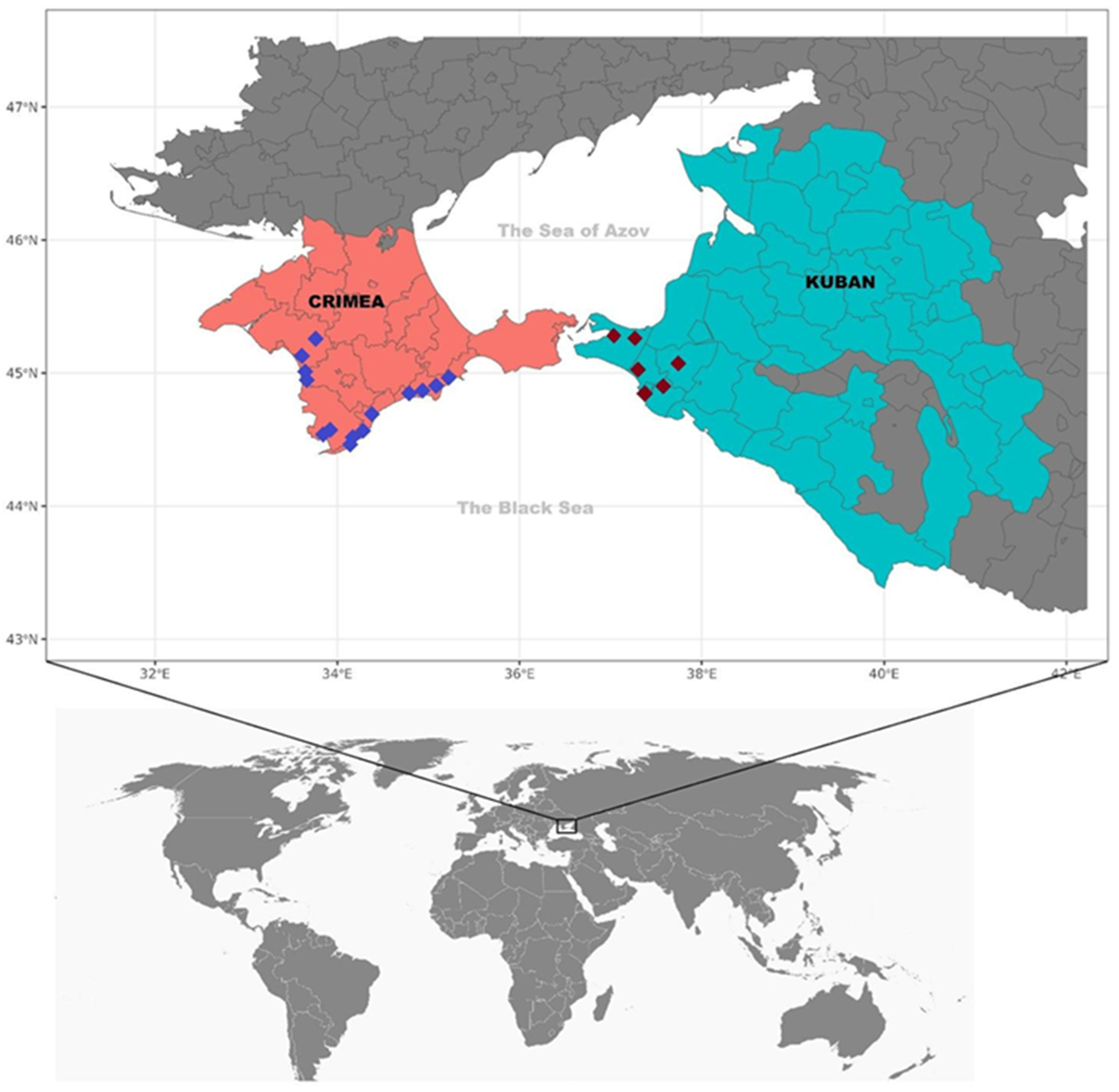

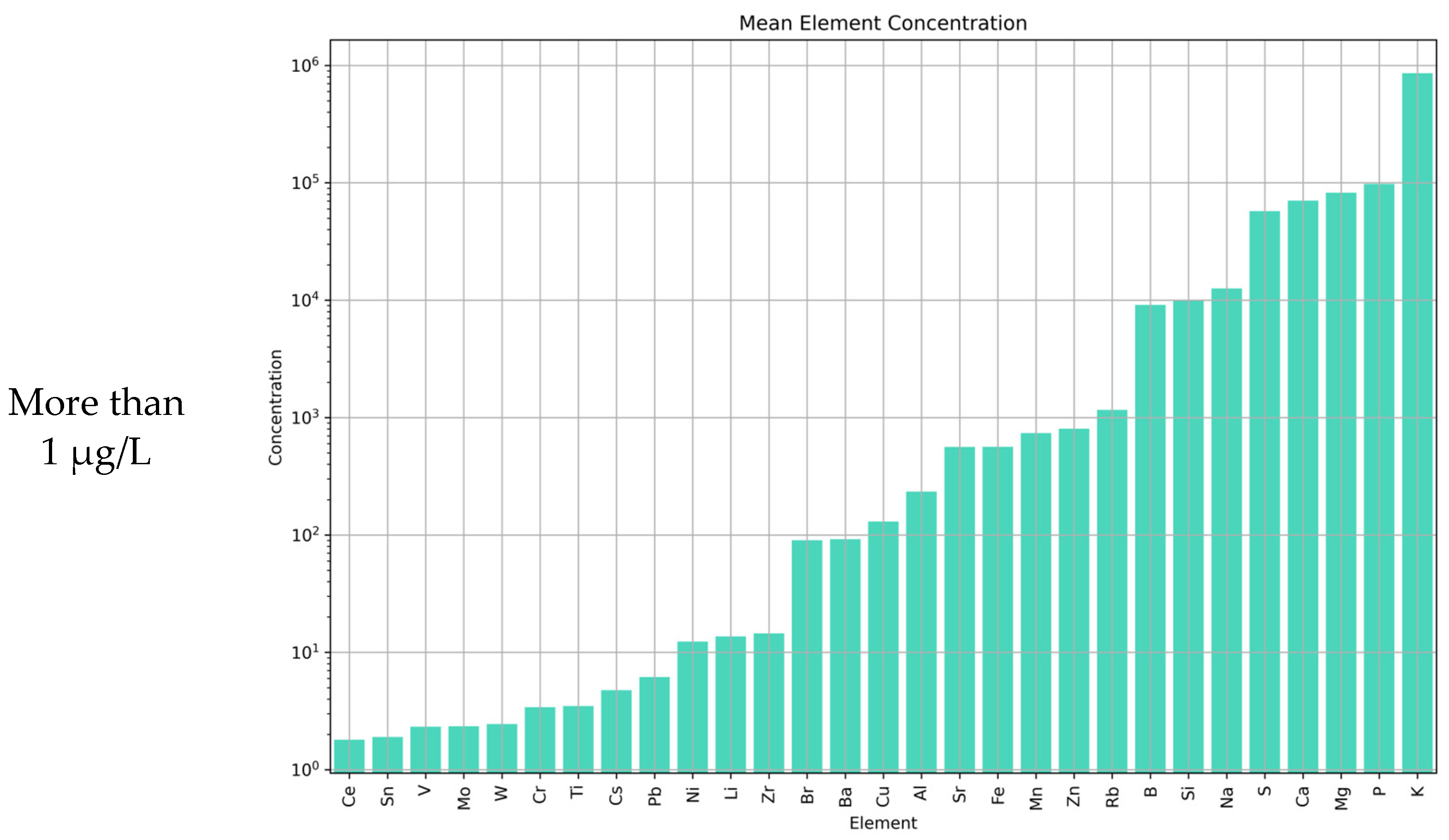
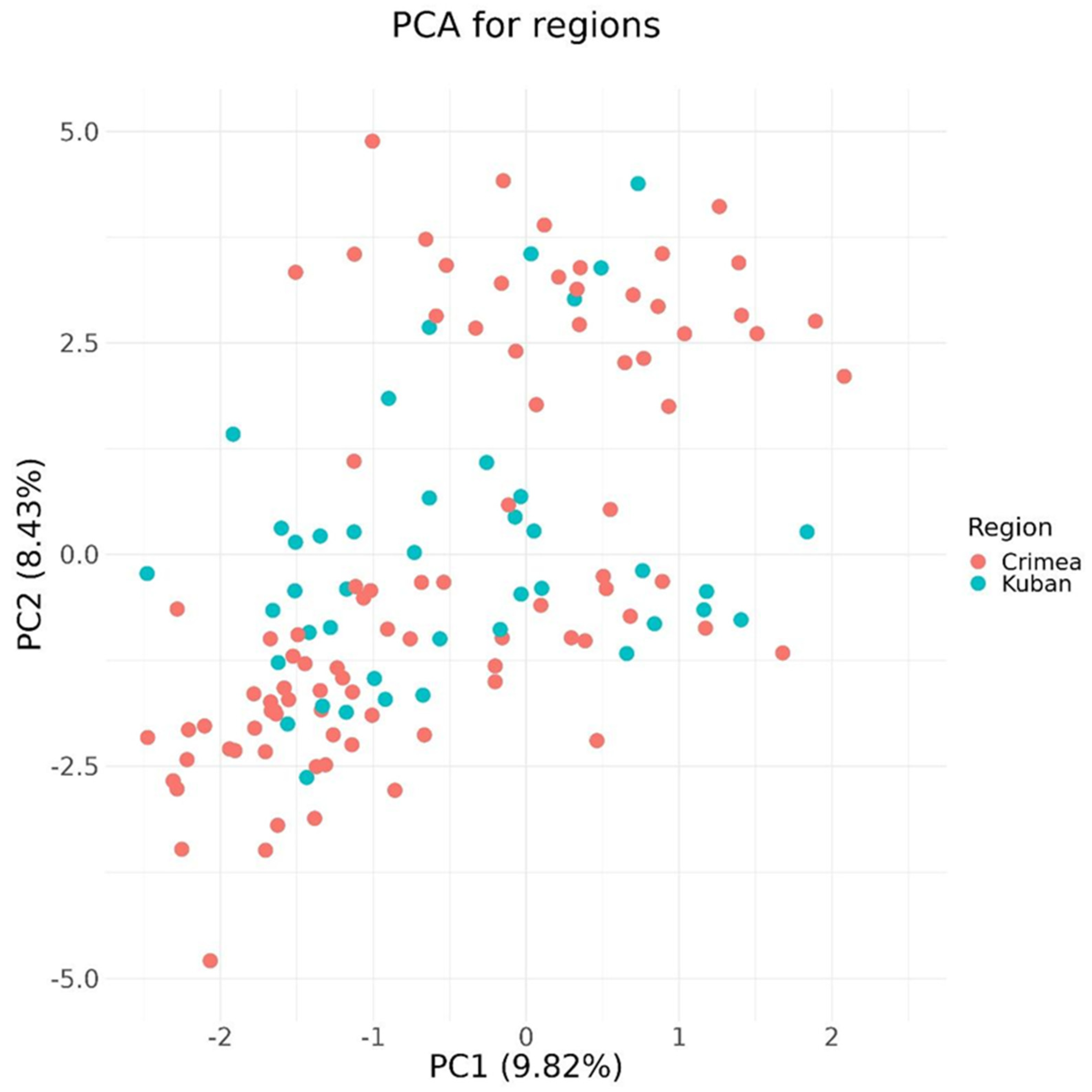
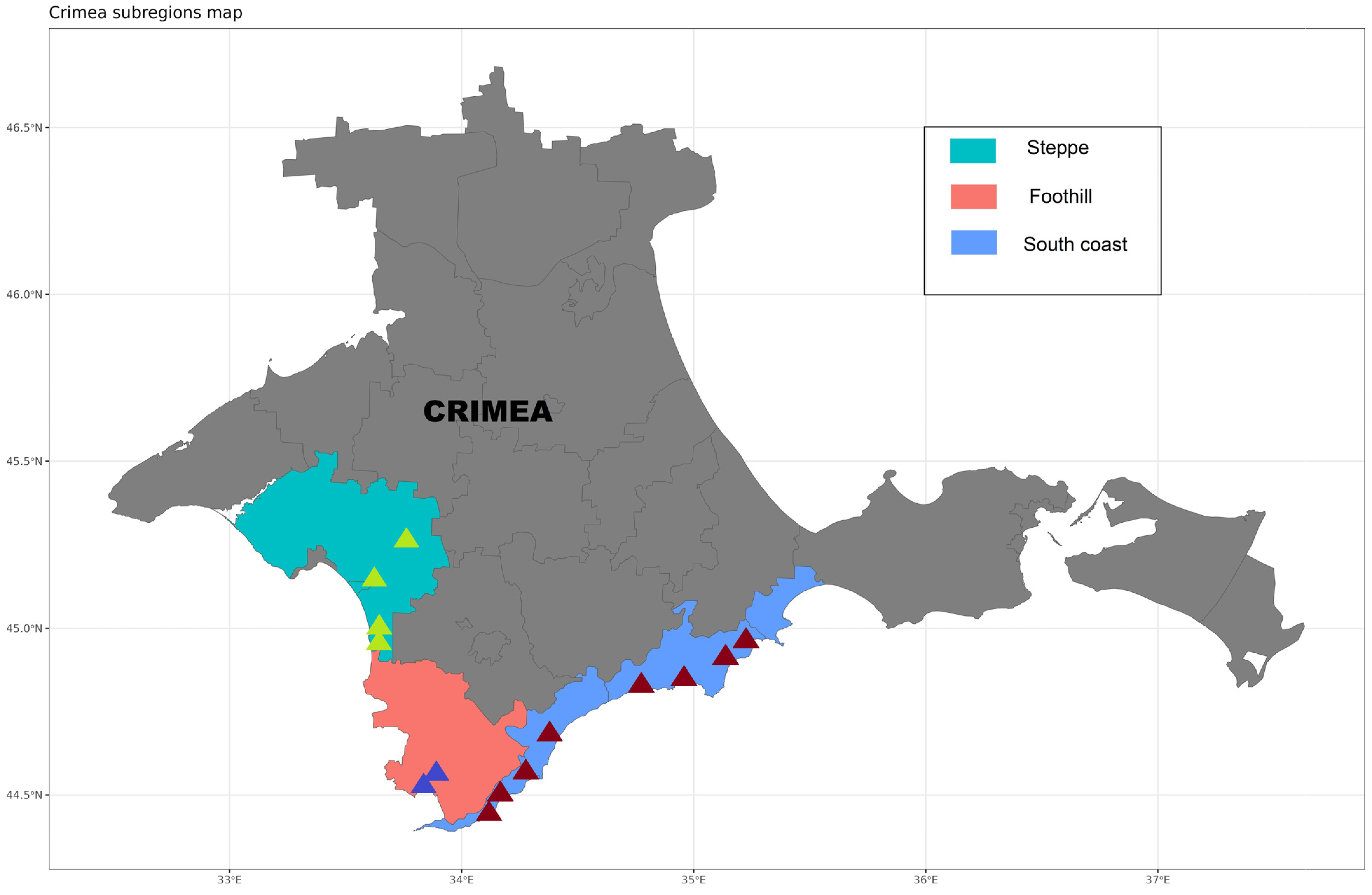
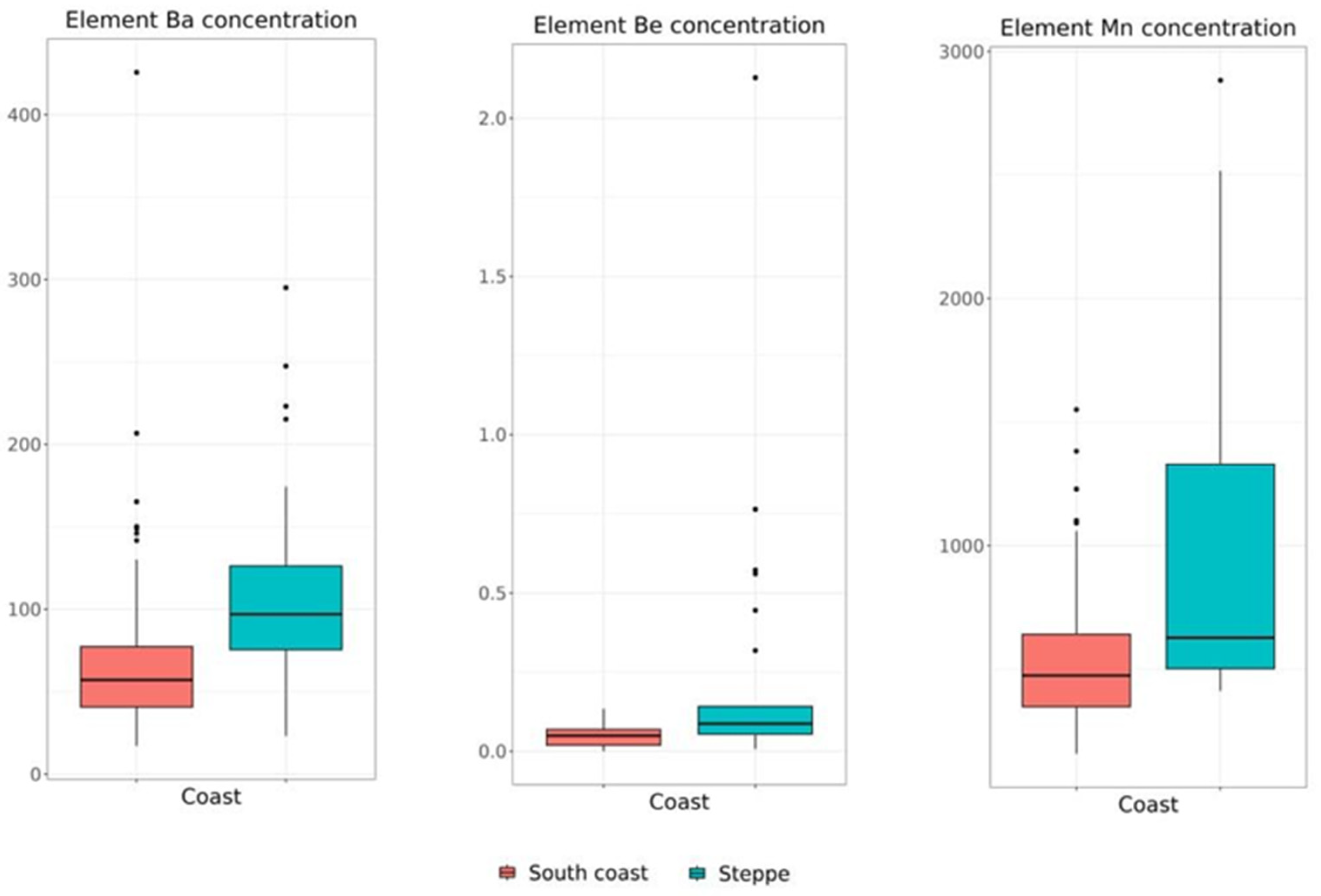
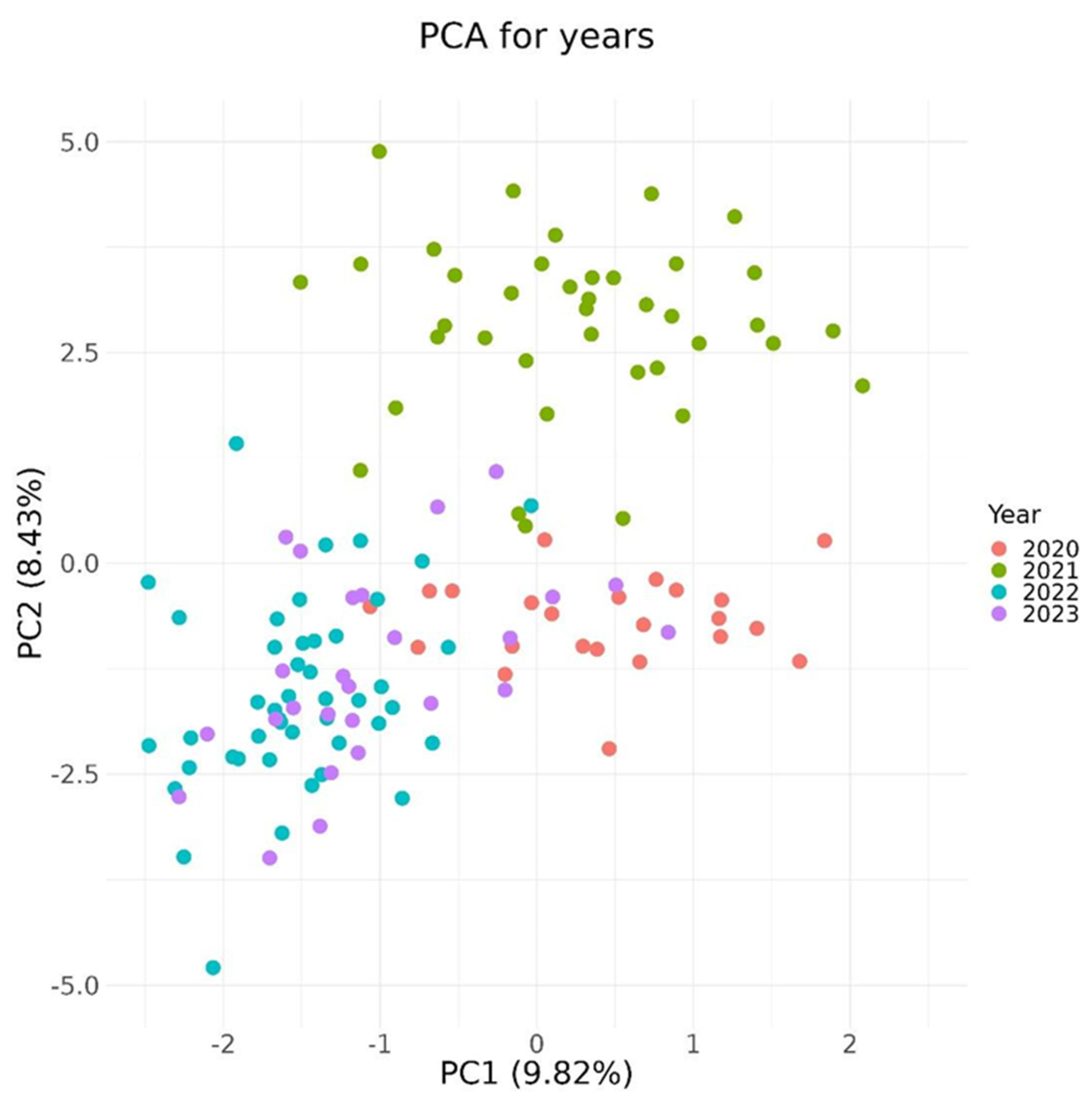
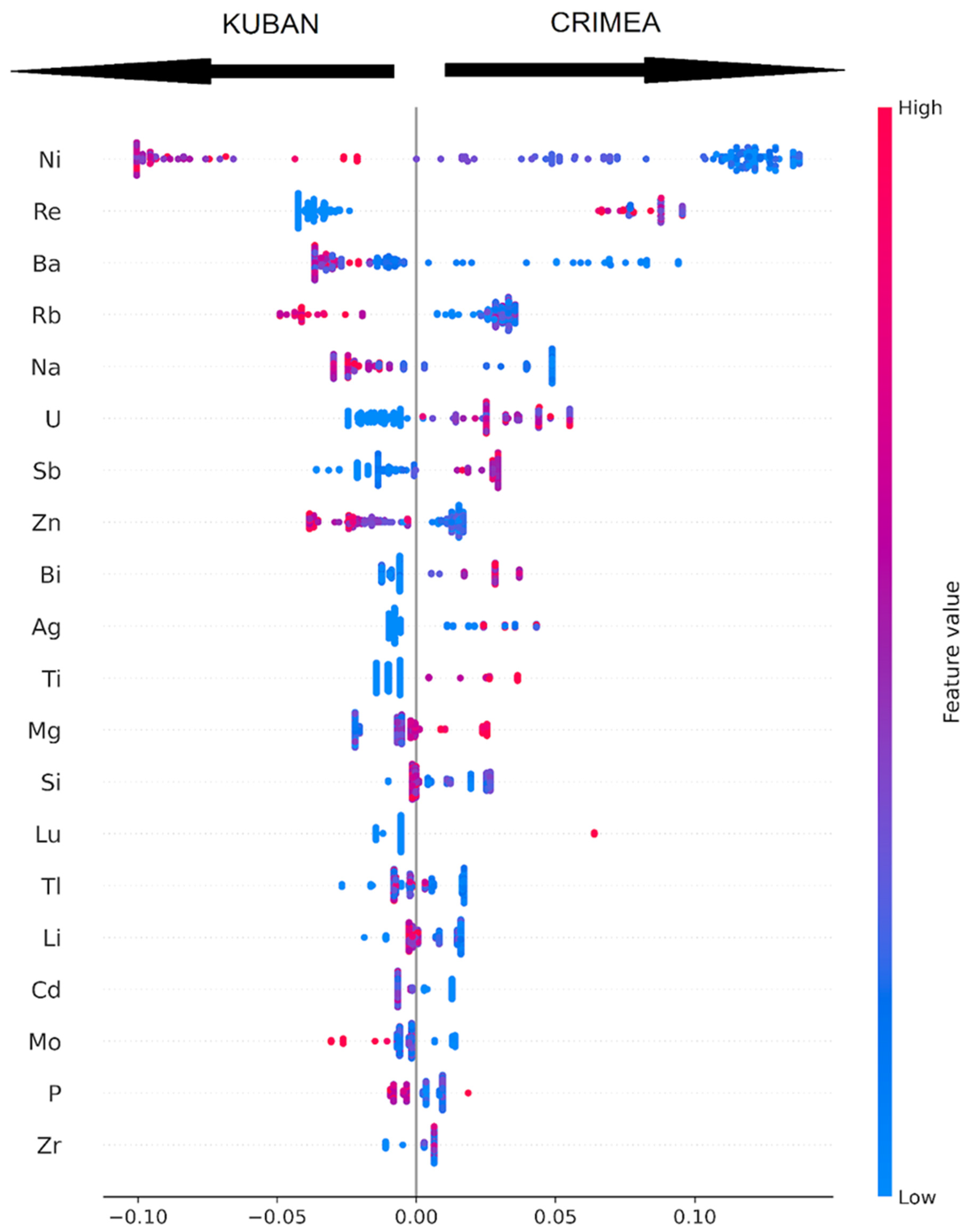
| Winery Zone | Number of Samples | Grape Varieties |
|---|---|---|
| Year of 2020 | ||
| Kuban | 13 | Chardonnay, Aligote, Cabernet Sauvignon, Saperavi, Krasnostop, Penvenec Magaracha, Pinot Blanc, Cabernet Franc, Yubilejnyj |
| Crimea | 17 | Chinuri, Malbec, Cabernet Sauvignon, Aligote, Kokur white, Shabash, Sary Pandas, Dzhevat Kara, Ekim Kara, Kefesia Crimea |
| Year of 2021 | ||
| Kuban | 8 | Aligote, Rhenish Riesling, Merlot, Saperavi, Cabernet Sauvignon, Krasnostop, Penvenec Magaracha |
| Crimea | 35 | Chinuri, Malbec, Cabernet Sauvignon, Aligote, Kokur white, Shabash, Sary Pandas, Dzhevat Kara, Ekim Kara, Kefesia Crimea, Kapselsky white, Kok pandas, Solnechnodolinsky, Rkatsiteli, Citron nutmeg, Tavkveri Magaracha, Riesling, Bastardo, Chardonnay, White Muscat, Merlot |
| Year of 2022 | ||
| Kuban | 15 | Aligote, Cabernet Sauvignon, Merlot, Chardonnay, Muscat, Cabernet Franc, Malbec, Saperavi, Penvenec Magaracha |
| Crimea | 36 | Cabernet Sauvignon, Aligote, Kokur white, Kefecia, Dzhevat Kara, Kimi Kara, Sary Pandas, Saperavi, Kok pandas, Kapselsky, Krona, Merlot, Malbec, Soldaya, Antey magarachsky |
| Year of 2023 | ||
| Kuban | 12 | Muscat, Sauvignon Blanc, Chardonnay, Riesling, Syrah, Saperavi, Cabernet Sauvignon, Merlot |
| Crimea | 16 | Sary Pandas, Kokur white, Kokur rassechennyj, Alburla, Kokur red, Kokurdes black, Rkatsiteli, Kefecia, Cabernet Sauvignon, Penvenec Magaracha, Krasnostop, Sangiovese, Shabash |
| Region | Element | Mean | SD | CI95 | Median | Iqr | Min | Max |
|---|---|---|---|---|---|---|---|---|
| Crimea | B | 7637.005 | 3534.772 | 6960.886–8313.123 | 6740.816 | 4342.926 | 2899.712 | 20,826.672 |
| Kuban | B | 12,376.831 | 7891.347 | 10,120.732–14,632.931 | 9078.932 | 10,688.664 | 4019.906 | 34,148.367 |
| Crimea | Ca | 67,442.275 | 22,213.511 | 63,193.354–71,691.195 | 65,000.53 | 26,665.862 | 28,763.554 | 154,356.604 |
| Kuban | Ca | 77,736.728 | 17,680.162 | 72,682.051–82,791.405 | 75,989.54 | 25,450.436 | 38,759.975 | 115,177.129 |
| Crimea | Cu | 82.59 | 82.842 | 66.744–98.436 | 62.323 | 71.051 | 1.744 | 690.86 |
| Kuban | Cu | 236.861 | 311.815 | 147.715–326.008 | 151.559 | 111.903 | 22.811 | 1742.521 |
| Crimea | Mn | 676.957 | 459.381 | 589.088–764.825 | 566.851 | 320.971 | 157.629 | 2883.012 |
| Kuban | Mn | 871.746 | 421.976 | 751.105–992.387 | 812.558 | 526.445 | 170.615 | 2198.142 |
| Crimea | Na | 11,578.113 | 9275.519 | 9803.924–13,352.301 | 8718.714 | 9153.031 | 1775.196 | 54,315.663 |
| Kuban | Na | 14,803.21 | 5338.224 | 13,277.037–16,329.384 | 13,599.198 | 5085.49 | 6387.147 | 38,506.102 |
| Crimea | Ni | 9.955 | 15.695 | 6.953–12.957 | 6.959 | 5.547 | 0.097 | 111.527 |
| Kuban | Ni | 19.467 | 15.873 | 14.929–24.005 | 17.781 | 10.159 | 0.688 | 107.379 |
| Crimea | Re | 0.021 | 0.022 | 0.017–0.025 | 0.015 | 0.019 | <DL | 0.12 |
| Kuban | Re | 0.01 | 0.015 | 0.006–0.014 | 0.007 | 0.007 | <DL | 0.095 |
| Crimea | Si | 9070.07 | 3508.267 | 8399.021–9741.118 | 8713.841 | 3810.774 | 3042.293 | 20,193.198 |
| Kuban | Si | 11,805.177 | 3279.205 | 10,867.667–12,742.686 | 11,663.206 | 3449.058 | 4945.78 | 22,879.321 |
| Crimea | Sn | 1.79 | 3.086 | 1.2–2.38 | 0.961 | 0.769 | 0.006 | 16.839 |
| Kuban | Sn | 2.192 | 4.587 | 0.881–3.503 | 0.353 | 0.783 | 0.04 | 18.018 |
| Crimea | U | 0.056 | 0.146 | 0.028–0.083 | 0.019 | 0.02 | <DL | 0.802 |
| Kuban | U | 0.013 | 0.01 | 0.01–0.016 | 0.011 | 0.011 | <DL | 0.042 |
Disclaimer/Publisher’s Note: The statements, opinions and data contained in all publications are solely those of the individual author(s) and contributor(s) and not of MDPI and/or the editor(s). MDPI and/or the editor(s) disclaim responsibility for any injury to people or property resulting from any ideas, methods, instructions or products referred to in the content. |
© 2024 by the authors. Licensee MDPI, Basel, Switzerland. This article is an open access article distributed under the terms and conditions of the Creative Commons Attribution (CC BY) license (https://creativecommons.org/licenses/by/4.0/).
Share and Cite
Oganesyants, L.A.; Panasyuk, A.L.; Sviridov, D.A.; Egorova, O.S.; Akbulatova, D.R.; Ganin, M.Y.; Shilkin, A.A.; Il’in, A.A. A Study of the Elemental Profiles of Wines from the North-Eastern Coast of the Black Sea. Separations 2024, 11, 148. https://doi.org/10.3390/separations11050148
Oganesyants LA, Panasyuk AL, Sviridov DA, Egorova OS, Akbulatova DR, Ganin MY, Shilkin AA, Il’in AA. A Study of the Elemental Profiles of Wines from the North-Eastern Coast of the Black Sea. Separations. 2024; 11(5):148. https://doi.org/10.3390/separations11050148
Chicago/Turabian StyleOganesyants, Lev A., Alexandr L. Panasyuk, Dmitriy A. Sviridov, Olesya S. Egorova, Dilyara R. Akbulatova, Mikhail Y. Ganin, Aleksey A. Shilkin, and Alexandr A. Il’in. 2024. "A Study of the Elemental Profiles of Wines from the North-Eastern Coast of the Black Sea" Separations 11, no. 5: 148. https://doi.org/10.3390/separations11050148
APA StyleOganesyants, L. A., Panasyuk, A. L., Sviridov, D. A., Egorova, O. S., Akbulatova, D. R., Ganin, M. Y., Shilkin, A. A., & Il’in, A. A. (2024). A Study of the Elemental Profiles of Wines from the North-Eastern Coast of the Black Sea. Separations, 11(5), 148. https://doi.org/10.3390/separations11050148






